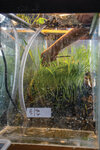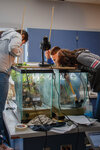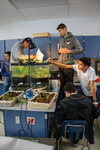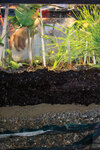




MANSON – High School general biology and honors biology students have teamed up for unique educational experience. The hands-on, problem-solving course earns students credits in both biology and language arts as they work their way through finding a solution for the minimalization of fertilizer leaching from orcharding into the pristine water in Lake Chelan.
With the realization that Chelan Valley thrives off its agriculture and tourism, the students were tasked to engineer an orchard and lake, ultimately developing a solution to a very real concern for local orchardists, explained Biology Teacher Erik Helleson. That concern being how to produce a thriving orchard without harming the quality of the lake water. “How do you add fertilizer, how do you add all the things that will help plants grow,” he expressed, “but not damage the water? So, we can keep the tourism but also keep the production in the area.”
During the first semester, general biology students completed a forensic simulation on the issue of leaching fertilizer in a made-up lake with algae bloom. The leaching caused the algae growth, in the simulation, to get out of control in the water and strongly effected the community’s tourism, fishing and displayed other negative consequences, “so, they learned the science behind the problem that we don’t want Lake Chelan to have,” Helleson explained. Into the second semester now, the students are using the problematic information learned from their simulations in the first semester to not only develop a solution, but also will be required to complete an informative presentation to staff and parents during conferences, which will discuss reasonings, development, findings and conclusions using a combination of media.
With an overall goal of resolving the issue of leaching fertilizer, the biology students have weekly tasks and milestones that must be met in order for each group’s experiments to be successful. Beginning with initial thumbnail sketches created in the first week, the groups have worked their way through the construction of the compositionally correct, small-scaled “orchard by the lake” replications. Each group was provided 45 seeds that they were allowed to choose from, including soy beans, corn and radishes, and planted the desired seeds into germination trays. Meanwhile, tanks were engineered utilizing compositionally relevant soil similar to that found in the orchards of Chelan Valley, into three sections of a gravely loam layer, and a gravely sand layer with a top layer of potting soil. An underground aquifer connecting the land to water was also a requirement of the engineering of the tank, with the option of a self-watering system. As an indicator for nitrate levels in the water, the groups used duckweed, which is a form of algae which surviving, growing and reproducing off nutrients in the water, such as nitrogen, potassium and phosphorous. Once germinated, produce seeds and duckweed were transplanted into the group’s prepared orchard based on the planned orchard mapping previously created.
To be successful in the project, all aspects of the orchard must be functionally comparable to real life. The tank with the “highest yield of orchard pants measured by height, percent of surviving plants, final weight of biomass and lowest duckweed population,” as stated in the project outline, will win the competition.
For weeks now, the students have been measuring and documenting the growth levels of crops and duckweed in their orchards. On the day Lake Chelan Mirror staff was present during the class period, the groups were informed of the excessively high nitrate levels present in their water. After a brief explanation from Helleson on nitrate levels allowable by the governing agencies, the students viewed a video which documented the occurrence of water contamination caused by mining in Holden, Wash. Based on cleanup methods used in the Holden Mine scenario, the groups were then tasked with creating a collection barrier that will either treat or pump water back into their crops.
For the remaining weeks in the semester, the students will continue to reanalyze and reengineer their projects, collecting data and testing theory through trial and error along the way.
Different areas of this project have been used in the PBL course at Manson High School in the past, explained Helleson, but “this is the first we got it exactly how we want it.” A special thanks to Dave Spanjar of Dave’s Apple Barrel Bark in Manson, Helleson added, for his donation of two of the sizes of rock bed needed to make this project possible for the students.
Comments
No comments on this item Please log in to comment by clicking here